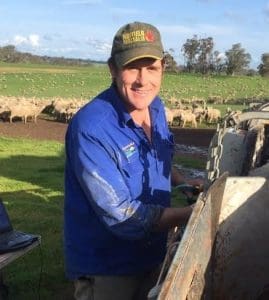 AUSTRALIA’S reliance on sheep and lamb saleyards is a barrier to profitability due to its extra costs, according to Nuffield scholar Michael Craig.
AUSTRALIA’S reliance on sheep and lamb saleyards is a barrier to profitability due to its extra costs, according to Nuffield scholar Michael Craig.
Mr Craig said saleyard selling involved a raft of additional transaction expenses, including yard fees, transport costs, and buyer and agent fees on both sides of a livestock transaction.
“We, as an industry, must continue to challenge the status quo because these additional costs directly impact on consumer prices and erode profitability.
“Additionally, saleyards have the potential to increase biosecurity and welfare risks, and to damage product through the unnecessary stress of loading and unloading animals,” he said.
He said the pricing of each animal sold through saleyards also did not take into account animal variation and, instead, used averages for live weight, fat cover and dressing percentage – another failing of the product-based supply chain.
“This method provides no incentive for the producer to boost the quality of their product.
“The challenge for industry now is to seriously consider if this system is the best long-term mechanism for creating a quality-focussed supply chain,” he said.
Australia’s sheep meat industry may export to more than 65 countries across the globe and enjoy good demand domestically, but the report from the 2015 Nuffield Scholar showed there may now be value in moving away from traditional supply chains to help meet growing consumer expectations of quality.
Mr Craig is general manager of ‘Tuloona Pastoral’ near Harrow, Victoria, a mixed broadacre livestock and cropping enterprise comprising 18,000 sheep, 500 cows and a 1400 hectare cropping program.
His Nuffield scholarship was supported by Meat & Livestock Australia and investigated the Australian sheep meat industry’s ability to create value in changing environmental, economic and social conditions. It took him on a study tour, where he researched supply chain models in the USA, New Zealand, Europe and the UK.
Mr Craig said to satisfy the producer, the processor and, most importantly, the consumer, industry should implement a transparent pricing model which includes metrics around intramuscular fat, fat cover and eye muscle depth and yield.
“If these systems are implemented, the challenge then is to ensure they can be relied on for their accuracy and can be used to re-engineer how the product is transacted within the chain.”
Mr Craig believes industry should foster a virtual mechanism with a pricing model based on Hot Standard Carcase Weight (HSCW), LMY and EQ for processors to secure supply of animals direct from farm, while improving communication and linkage within the chain, thereby reducing unnecessary costs.
“Currently, sheep price reporting is based on a simple supply and demand method, but this could change to focus on a system which reflects quality attributes,” he said.
Mr Craig said for improvement to be made, producers need to support the implementation of these changes from a grass-roots level.
“Strong leadership from the production sector will be key to driving change with the incentives being better prices for higher quality,” he said.
“If the Australian sheep and lamb meat industry wants to build upon its reputation for quality and further differentiate itself in the world red meat market, then it is imperative that our transaction and pricing signals reflect metrics around processing efficiency and measurable eating quality attributes, which saleyards will struggle to do.”
Mr Craig said Australia’s sheep meat prices are not currently a reflection of quality, but by implementing a system which reflects objective measurable the industry could take steps to assure the quality of product.
“MLA and industry will have to investigate how to move the current short term Eastern States Trade Lamb Indicator to include metrics around quality and whether this creates a need for mandatory price reporting of all carcases sold, thereby improving the traceability of products.”
Based on his research, Mr Craig provided several recommendations to boost product quality, with a particular focus on investing in research and new technology.
“The industry, together with good policy settings from government, should continue to invest in objective measurements around Lean Meat Yield (LMY) and Eating Quality (EQ), and conduct research to link on-farm production to specific product attributes,” he said.
Mr Craig’s full scholarship report is available here.

Mr Craig is correct. Saleyards are a system of price discovery developed about 2000 BC — maybe before that. There are better systems available. I encourage the sheep meat industry to pursue objective value-based marketing like the wool industry has achieved over 30 years ago.
It is encouraging to see the increase in usage of the AuctionPlus platform as a virtual saleyard with a lot of benefits over the old physical platform. This platform is an incremental improvement. However, Mr Craig is correct in that farmers will discover greater returns by price discovery further down the supply chain.
Mr Craig’s comment on the biosecurity implications of the physical saleyards is something that has worried me for some time. Most Foot and Mouth Disease outbreaks have been magnified greatly by going through saleyards. To a small contagious RNA picornavirus like FMD saleyards are a very convenient meeting place for host and virus.
Aggregating animals together then sending them around the country is brain-dead behaviour really. Any rational national biosecurity strategy should recognise this and appropriately allocate costs to the high-risk supply chains. AuctionsPlus or direct sales are a safer way to market stock than physical saleyards.